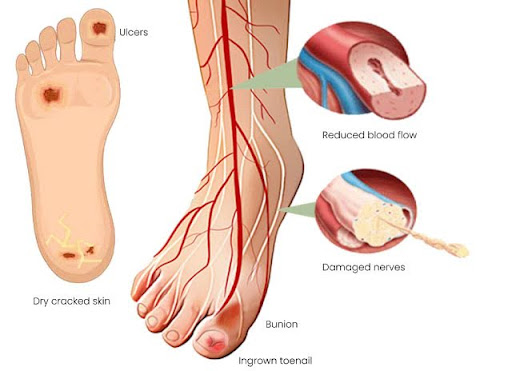Diabetic foot ulcers are a serious complication of diabetes that can lead to severe consequences if not properly managed. Visuals can be a powerful tool in understanding the nature and progression of these ulcers.
By examining diabetic foot ulcer pictures in detail, we can gain valuable insights into their appearance, stages, and the critical importance of early detection and treatment.

Diabetic foot ulcers often begin as minor wounds, but due to poor circulation and nerve damage associated with diabetes, they can quickly worsen. Through a series of images, we can see how these ulcers evolve from red, inflamed patches to deep, infected wounds if left untreated.
Understanding Diabetic Foot Ulcer Pictures
Understanding diabetic foot ulcer pictures is crucial for grasping the severity and progression of this common diabetes complication. These images provide a visual representation of the different stages and types of foot ulcers, highlighting the importance of early detection and intervention.

Diabetic foot ulcers often begin as small, unnoticed wounds. Initial pictures may show minor skin breaks or redness, often overlooked due to reduced sensation in diabetic patients. Diabetic foot ulcer pictures reveal deeper, more severe tissue damage, and ulcer progress.

Intermediate stages might show increased redness, swelling, and signs of infection like pus or foul odor. Advanced stages, captured in the most alarming pictures, depict extensive tissue loss, deep craters, and exposed bone, underscoring the potential for severe complications such as gangrene or amputation.

Diabetic Foot Ulcer Pictures
In advanced stages, diabetic foot ulcer pictures can become quite graphic. These images often show deep, open wounds that expose underlying tissues, and in severe cases, even bone.

The surrounding skin may appear blackened, indicating necrosis, or tissue death, which can lead to gangrene. Such severe conditions highlight the urgent need for medical intervention to prevent amputation.

Why are Diabetic Foot Ulcer Pictures Necessary?
Diabetic foot ulcer pictures are essential for managing and understanding diabetic foot complications. These images help in early detection, educate patients and healthcare providers, raise awareness about proper foot care, improve communication, and serve as visual references for identifying different stages of foot ulcers. Here’s why they are necessary:

- Early Detection:
- Diabetic foot problems can start small and painless, making them easy to miss.
- Diabetic foot ulcer pictures show early signs like redness, blisters, or minor sores, helping catch issues before they worsen.
2. Educational Tool:
- They educate patients and healthcare providers about how foot ulcers progress.
- Early-stage images show minor wounds, while advanced-stage pictures reveal severe damage, making the condition easier to understand.
3. Awareness and Prevention:
- Images highlight the importance of regular foot checks, good hygiene, and appropriate footwear.
- Seeing the potential consequences of neglect encourages people to take preventive measures seriously.
4. Improved Communication:
- Diabetic foot images provide a common reference for patients and doctors.
- Patients can compare their feet to the images and accurately describe their symptoms, leading to better diagnosis and treatment.
5. Visual Reference:
- They serve as a visual guide for identifying different stages of foot ulcers.
- Patients and caregivers can recognize when a wound is worsening and seek medical help promptly.
How to Get Rid of Diabetic Foot Ulcer?
Getting rid of a diabetic foot ulcer requires careful treatment and consistent care. Here’s a simple guide with steps to help heal a diabetic foot ulcer:

1. Consult a Doctor:
- The first step is to see a healthcare professional. They can assess the ulcer and recommend the best treatment plan.
2. Keep the Ulcer Clean:
- Wash the ulcer gently with mild soap and water.
- Pat it dry with a clean towel and avoid scrubbing, which can cause more damage.
3. Apply Medication:
- Use prescribed ointments or creams. These medications help fight infection and promote healing.
- Always follow your doctor’s instructions on how to apply them.
4. Dress the Wound:
- Cover the ulcer with a sterile bandage or dressing.
- Change the dressing as recommended by your healthcare provider to keep the wound clean and dry.
5. Manage Blood Sugar Levels:
- Keep your blood sugar levels within the target range. High blood sugar can slow down the healing process.
- Follow your diabetes management plan, including diet, exercise, and medication.
6. Reduce Pressure on the Ulcer:
- Avoid walking barefoot or putting pressure on the affected foot.
- Use special shoes, inserts, or a cast to relieve pressure and protect the ulcer.
7. Improve Circulation:
- Exercise regularly to enhance blood flow, but avoid activities that put pressure on the ulcer.
- Avoid smoking, as it can worsen circulation problems.

8. Regular Check-Ups:
- Visit your doctor regularly to monitor the healing process.
- They might suggest additional treatments like antibiotics for infection or special procedures to clean the wound.
9. Healthy Diet:
- Eat a balanced diet rich in vitamins and minerals to support overall health and healing.
- Stay hydrated by drinking plenty of water.
10. Monitor for Signs of Infection:
- Watch for signs like increased redness, swelling, warmth, pus, or a foul odor.
- Contact your healthcare provider immediately if you notice any of these signs.
Frequently Asked Questions
What are diabetic foot ulcers?
Diabetic foot ulcers are open sores or wounds that occur on the feet of individuals with diabetes. They typically develop due to poor circulation and nerve damage, common complications of diabetes.
Why are diabetic foot ulcer pictures important?
Diabetic foot ulcer pictures are crucial for early detection, education, and awareness. They help patients and healthcare providers identify the stages and severity of ulcers, promoting timely and effective treatment.
How can diabetic foot ulcers be detected early?
Early detection involves regular foot inspections to spot signs such as redness, blisters, or minor sores. Comparing these observations to diabetic foot images can help identify issues before they worsen.
What steps should be taken if a diabetic foot ulcer is detected?
Consult a doctor immediately, keep the ulcer clean, apply prescribed medication, and cover it with a sterile dressing. Besides, manage blood sugar levels, reduce pressure on the ulcer, and follow your healthcare provider’s instructions closely.
How can diabetic foot ulcers be prevented?
Preventive measures include maintaining good foot hygiene, wearing appropriate footwear, managing blood sugar levels, and conducting regular foot checks. Education on recognizing early signs through diabetic foot images can also be beneficial.
Why is managing blood sugar levels important for treating foot ulcers?
High blood sugar levels can impede the healing process and increase the risk of infection. Keeping blood sugar within the target range is crucial for effective ulcer treatment and overall health.
What role does footwear play in managing diabetic foot ulcers?
Proper footwear helps reduce pressure on the foot, preventing ulcers from worsening. Special shoes, inserts, or casts may be recommended to protect the affected area and support healing.
Conclusion
Diabetic foot ulcer is a common disease among all kinds of people. Especially, those who have diabetes. But it can stand as a fatal problem for the human body. By detecting this early, anyone can lessen the suffering.
Diabetic foot ulcer pictures help us get the initial idea about the disease. People can find their types of foot ulcers, understand the radius of the disease, and take the steps to remedy. In this blog, we showed the diabetic foot ulcer pictures and informed you about what to do when you face this. Follow the procedure and keep yourself forward with this.

Leave a Reply